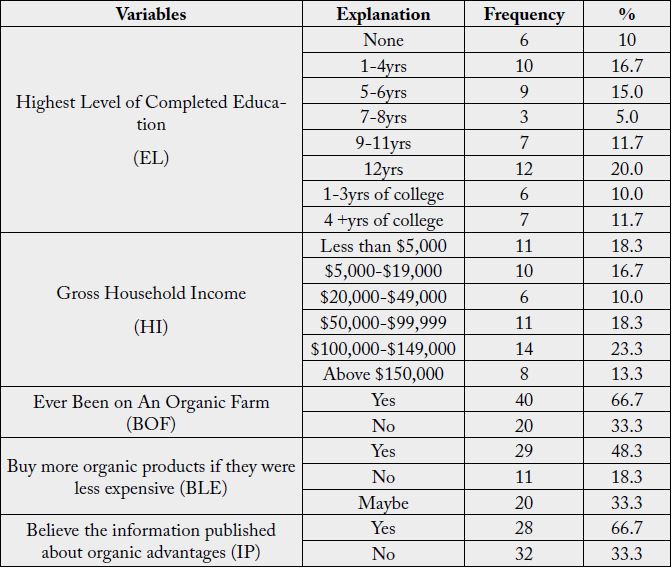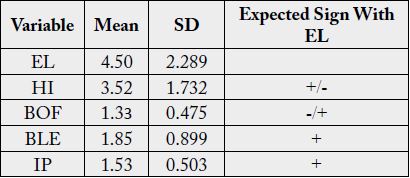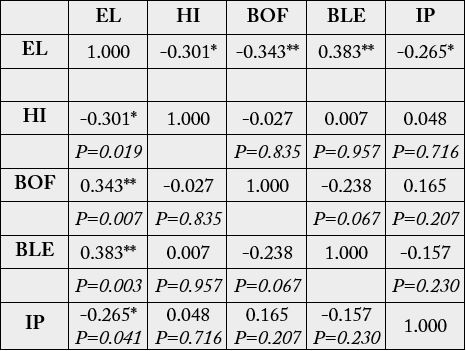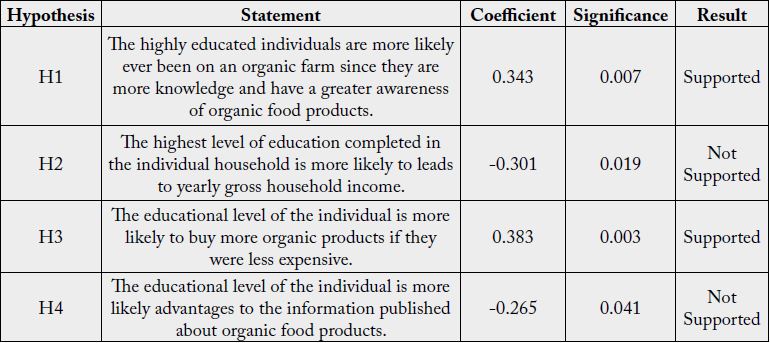Biography
Interests
Jacob Oluwoye
Professor of Transportation and Environmental Health & Director Center for Urban and Rural Research (CURR) Department of Community and Regional Planning College of Agricultural, Life and Natural Sciences Alabama A&M University, USA
*Correspondence to: Dr. Jacob Oluwoye, Professor of Transportation and Environmental Health & Director Center for Urban and Rural Research (CURR) Department of Community and Regional Planning College of Agricultural, Life and Natural Sciences Alabama A&M University, USA.
Copyright © 2019 Dr. Jacob Oluwoye. This is an open access article distributed under the Creative Commons Attribution License, which permits unrestricted use, distribution, and reproduction in any medium, provided the original work is properly cited.
Abstract
The purpose of this paper is to examine the relationships between consumers years of educational
level completed and other sources of motivations towards consumers attitude to organic food
products among samples of Riverdale residents in Georgia, United State of America.
The data was obtained from consumers in the vicinity of large shopping malls located in Riverdale,
Georgia through the design of a questionnaire survey. Data collection took place last year August-
December, 2018 in Riverdale, Georgia. The data collection survey instrument was designed in two
sections. Purchasers were approached during their food shopping in outlets of three retail chains in two different areas of Riverdale (one outlet per chain) using a structured questionnaire. Overall,
80 people were approached, 60 of which were qualified for the sample included in the time frame
of the survey (57.5 percent). SPSS IBM Statistics software v.23 was used for all statistical analysis.
The interaction highest educational level completed was significant with knowledge/awareness of
buying more organic products if they were less expensive with an estimated value of 0.383 at the
significance level of 0.003 at 0.01level (2-tailed), which means that awareness moderate positively.
Highest educational level completed and ever been on an organic farm was also significantly
associated with an estimated value of 0.343 at the significance of 0.007 at 0.01 levels (2-tailed).
The relationship between interaction term of highest educational level completed and yearly gross
household income was also significant with an estimate of - 0.301with significance of 0.019 at the
0.05 level (2-tailed). The significance of the highest educational level completed and its interaction
term with information published about organic food products was estimated value of -0.265 found
to be the significance of 0.041 at the 0.05 level (2-tailed) but the hypothesis was not supported as
you can see from table 4 above.
The study focused on knowing the significance of consumers years of educational level completed
and other sources of motivations towards consumers attitude to organic food products among
samples of Riverdale residents in Georgia, United State of America. It should be noted that
consumers educational level is proportionately related to buying more organic products if they were
less expensive and also, ever been on an organic farm also negatively affects to buy more organic
products if they were less expensive. Furthermore, increases in educational level and buy more
organic products if they were less expensive are other sources of motivation that positively affect
the attitude towards organic food products. Policymakers should pay close attention to promoting
awareness and consciousness levels and promoting the health benefits of organic foods in order to
stimulate real purchasing actions. The findings of this study have important implications for the
organic stakeholders, farmers and the food industry in general.
Introduction
Over the past 20 years, organic farming has grown rapidly transforming the European countryside. Since
the 1992 MacSharry reforms, the European Union has modified its Common Agricultural Policy (CAP)
to include payments to farmers for the provision of environmental services and the preservation of nature.
Among the agri-environmental measures, payments to farmers producing under organic methods constitute
a major component of the Second Pillar of the Common Agricultural Policy, which explicitly focuses on
Rural Development and which has gained in significance over the last years. Organic production fulfills
environmental. The rapid growth of the U.S. organic industry has caused a major shift in the types and
numbers of organic food retailers, manufacturers, and distributors and has widened the retail customer base.
A growing appetite for organic food in the United States translated into an increase in retail sales between 1997 and 2008. Over these years, the organic food sector transformed; by the time retail sales reached $21.1 billion in 2008, structural changes had revamped organic food marketing [1,2]. Retailing organic food changed as traditional purveyors of organic food faced increased competition from companies new to the sector, with organic food sold not only in natural-products stores, such as Whole Foods and food cooperatives, but also in traditional supermarkets such as Safeway, big-box stores such as Wal- Mart, and club stores such as Costco. Organic makers by 2008 were either competitory directly with standard food makers or had been subsumed by standard companies.
The purpose of this paper was to examine the relationships between consumer’s years of educational level
completed and other sources of motivations towards consumer’s attitude to organic food products among
samples of Riverdale residents in Georgia, United State of America.
Insights from the Body of Knowledge
Paul and Rana (2012) [3] reported that product quality (sensory qualities such as good appearance and
smell, and being delicious, healthy and safe) is among the factors that increase the positive attitude. It has
been determined that women have more positive attitudes towards organic food than male consumers.
Furthermore, increases in education and income levels are other sources of motivation that positively affect
the attitude towards organic food. Moreover, the fact that consumers are older increases the positive attitudes
[4]. However, previous studies reported that living metropolitan areas have an impact on organic food
consumption, and in this regard, people living in cities have come forward (Joshi & Rahman, 2017) [5-19].
It should be noted that some scholars are still working to provide valid information on strategic aspects such
as the market segmentation [11].
Callwood, (2013) [20,21] reported that psychological factors that influence an individual’s decision when purchasing as the individual’s motivations, perceptions, learning, and beliefs. Furthermore, consumer behavior may be defined as the mental, emotional, and physical activities related to purchasing, utilizing or disposing of products and services that satisfies a need [22,23]. It should be noted that attitudes affect intentions; the more desirable the attitude is, the greater it will, and intention to carry out a particular behavior will be [24]. However, Tarkiainen and Sundqvist (2009) [24] claim that attitudes are communicated between people, and thus, people with positive attitudes regarding a product will affect the attitudes of their surrounding people. As a result of this crossover effect, subjective norms will be seen as a precursor of attitudes in this study. Among the small number of studies that studied the subjective norms related to the purchase of organic food, it was discovered that there is an important relationship between subjective norms and attitudes of individual [10,11,16,25,26]. Furthermore, Klöckner (2012) [27] explains the complexity of human decisionmaking concerning purchasing organic food. Their model framework is outlined with the nested structure of decision, and the impact of earlier decisions has on the decisional space of later decisions. Environmental consideration has been suggested as a motivating factor. Ling (2013) [28] evaluated consumers’ intent to purchase the green product as a means of examining the driving variables that influence consumers’ purchase intent. Other studies have indicated the relevance of socio- demographic and cultural factors such as, product quality, price, place of sale, ambience, country of origin, and convenience in purchasing affect purchase decisions of food consumers [29-32]. Shafie and Rennie (2012) [33] suggested that future studies should go for a consumer-based approach which is important not only for consumers but also regarding responses to changes in market dynamics.
Hypotheses
H1. The highly educated individuals are more likely not to be on the organic farm since they are more
knowledgeable and have a greater awareness of organic food products.
H2. The highest level of education completed in the individual household is more likely to leads to yearly
gross household income.
H3. The educational level of the individual is more likely to buy more organic products if they were less
expensive.
H4. The educational level of the individual is more likely advantages to the information published about
organic food products
Research Materials and Methods
The research paper goal necessitated the identification of the various factors that influence the purchase of
organic food. The literature review was used in the identification of potential factors affecting a consumers
purchasing behavior of organic food products. Following the literature review research phase, the researchers
conducted a number of semi-structured interviews with industry experts in order to gather qualitative insight
into what had been uncovered in the academic literature. The data are obtained from consumers in the
vicinity of large shopping malls located in Riverdale, Georgia through the design of a questionnaire survey.
Data collection took place last year between August-December, 2018 in Riverdale, Georgia. The data collection
survey instrument is designed in two sections. In the first section, consumers’ demographic characteristics
(e.g. gender, age, family size, marital status, gross household income, education level) were included. In
the second section, consumers knowledge/awareness of organic food products. Purchasers were approached
during their food shopping in outlets of three retail chains in two different areas of Riverdale (one outlet per
chain) using a structured questionnaire. Overall, 80 people were approached, 60 of which were qualified for
the sample included in the time frame of the survey (57.5 percent). SPSS IBM Statistics software v.23 was
used for all statistical analysis.
Analysis and Results

Ever been on an organic farm distribution of the consumers participating in the research has values (66.7% yes and 33.3% no). It is possible to say that the participants with the highest education will not eager to visit the organic farm because they are knowledgeable about the organic food product. The highest Education levels completed of participants was 20% of consumers with 12years while 16.7% of consumers with 1-4years and 15.0% of consumers with5-6years as shown in table 1 above. Furthermore, 21.7% of consumers with 1-to 4years above with college education. Examination of participants based on the distribution of their gross household income, 35% of consumers participating in the research can be classified as low income less than $20,000 per year and 28.3% can be classified as middle income of above $20,000-$99,999 per month while the gross household income of above $100,000 per year can be classified as high-income ratio of 36.6%. Thinking of buying more organic products if they were less expensive 48.3% of consumers participating in the research say Yes, while 33.3% say Maybe and 18.3% say No that will not. However, with regards to the belief of consumers in regards to the information published about organic advantages, 66.7% say Yes while 33.3% say No as shown in table 1 above.
Descriptive Analysis
The variables profile of the overall sample (n=60) is shown in Table 2. The mean of each variable revealed
respondents’ attitudes towards organic food products. The standard deviation shows the size of the range
of answers (fairly high in almost all cases based on these results). The relatively high standard deviation
also reflects a divergence of opinion by respondents on most questions. Using the collected dataset of
organic purchase behavior, the author found the min and max. This is further reflected by the minimum and
maximum answers provided for each variable.

Note: EL= Highest Level of Completed Education HI= Gross Household Income BOF= Ever Been on an Organic Farm BLE= Buy more organic products if they were less expensive IP= Believe the information published about organic advantages
The relatively high standard deviation from table 2 above also reflects a divergence of opinion by respondents on most questions. Using the collected dataset of demographic characteristics and knowledge/awareness of organic food products, the author found the min and max. This is further reflected by the minimum and maximum answers provided for each variable.

*. Correlation is significant at the 0.05 level (2-tailed).
**. Correlation is significant at the 0.01 level (2-tailed).
Table 3 above shows the Spearman rho correlation r and its significant levels for the selected variables. However, the results as per table 4 present the coefficient for the selected variables. The interaction highest educational level completed was significant with knowledge/awareness of buying more organic products if they were less expensive with an estimated value of 0.383 at the significance level of 0.003 at 0.01level (2- tailed), which means that awareness moderate positively. Highest educational level completed and ever been on an organic farm was also significantly associated with an estimated value of 0.343 at the significance of 0.007 at 0.01 levels (2-tailed). The relationship between interaction term of highest educational level completed and yearly gross household income was also significant with an estimate of -0.301with significance of 0.019 at the 0.05 level (2-tailed). The significance of the highest educational level completed and its interaction term with information published about organic food products was estimated value of -0.265 found to be the significance of 0.041 at the 0.05 level (2-tailed) but the hypothesis was not supported as one can see from table 4 above [34].

Concluding Remarks
The study focused on knowing the significance of consumers years of educational level completed and other
sources of motivations towards consumers attitude to organic food products among samples of Riverdale
residents in Georgia, United State of America. It should be noted that consumers educational level is proportionately
related to buying more organic products if they were less expensive and also, ever been on an
organic farm also negatively affects to buy more organic products if they were less expensive. Furthermore,
increases in educational level and buy more organic products if they were less expensive are other sources of
motivation that positively affect the attitude towards organic food products. Policymakers should pay close
attention to promoting awareness and consciousness levels and promoting the health benefits of organic
foods in order to stimulate real purchasing actions. The findings of this study have important implications
for the organic stakeholders, farmers and the food industry in general.
Acknowledgement
The author is profoundly grateful to the Cooperative State Research, Education, and Extension Services
(CSREES). This material is based upon work that is supported by the National Institute of Food and Agriculture,
U.S. Department of Agriculture, Evans-Allen project under ALAX- 015-0517 number and also to
Graduate Student for collecting the pilot data and Graduate Assistant (Mr. Damilola Dairo) for questionnaires
coding.
Bibliography

Hi!
We're here to answer your questions!
Send us a message via Whatsapp, and we'll reply the moment we're available!